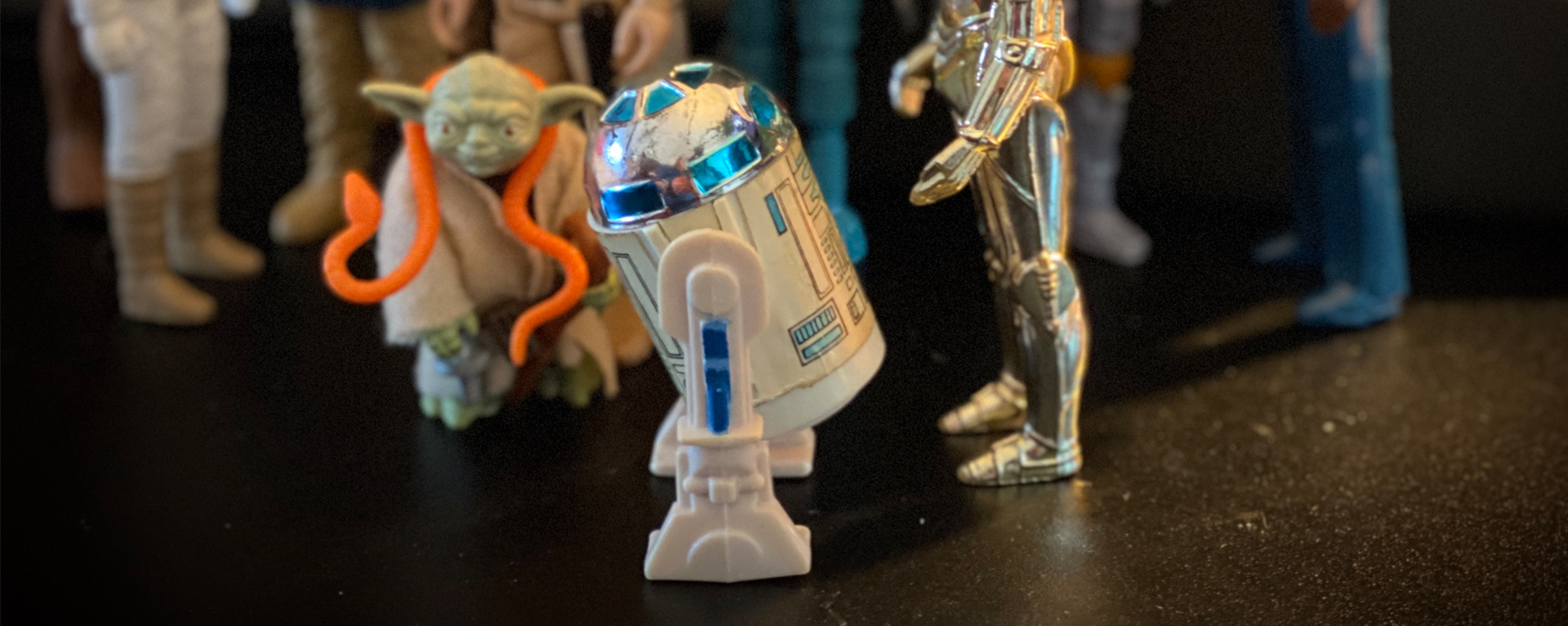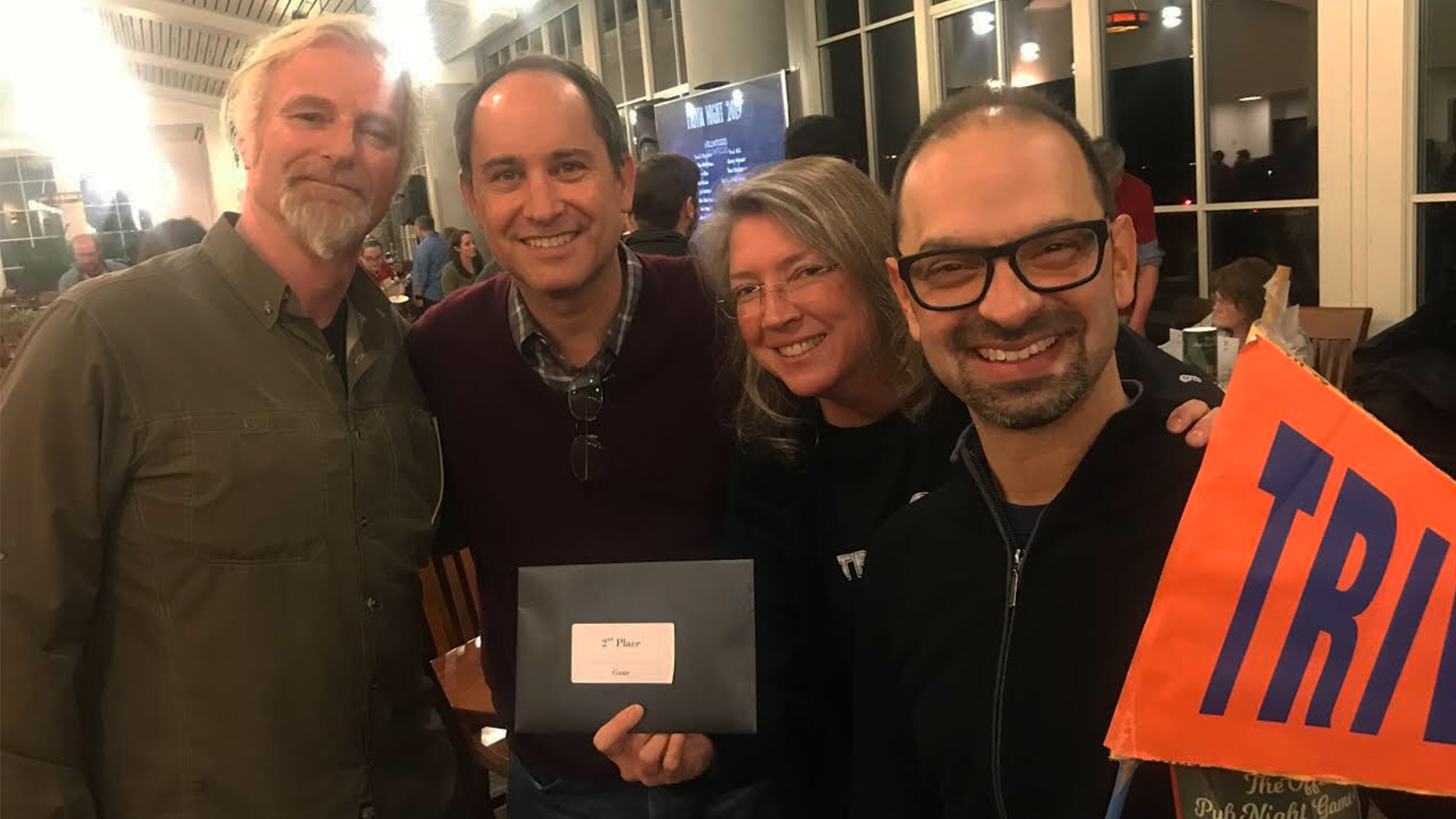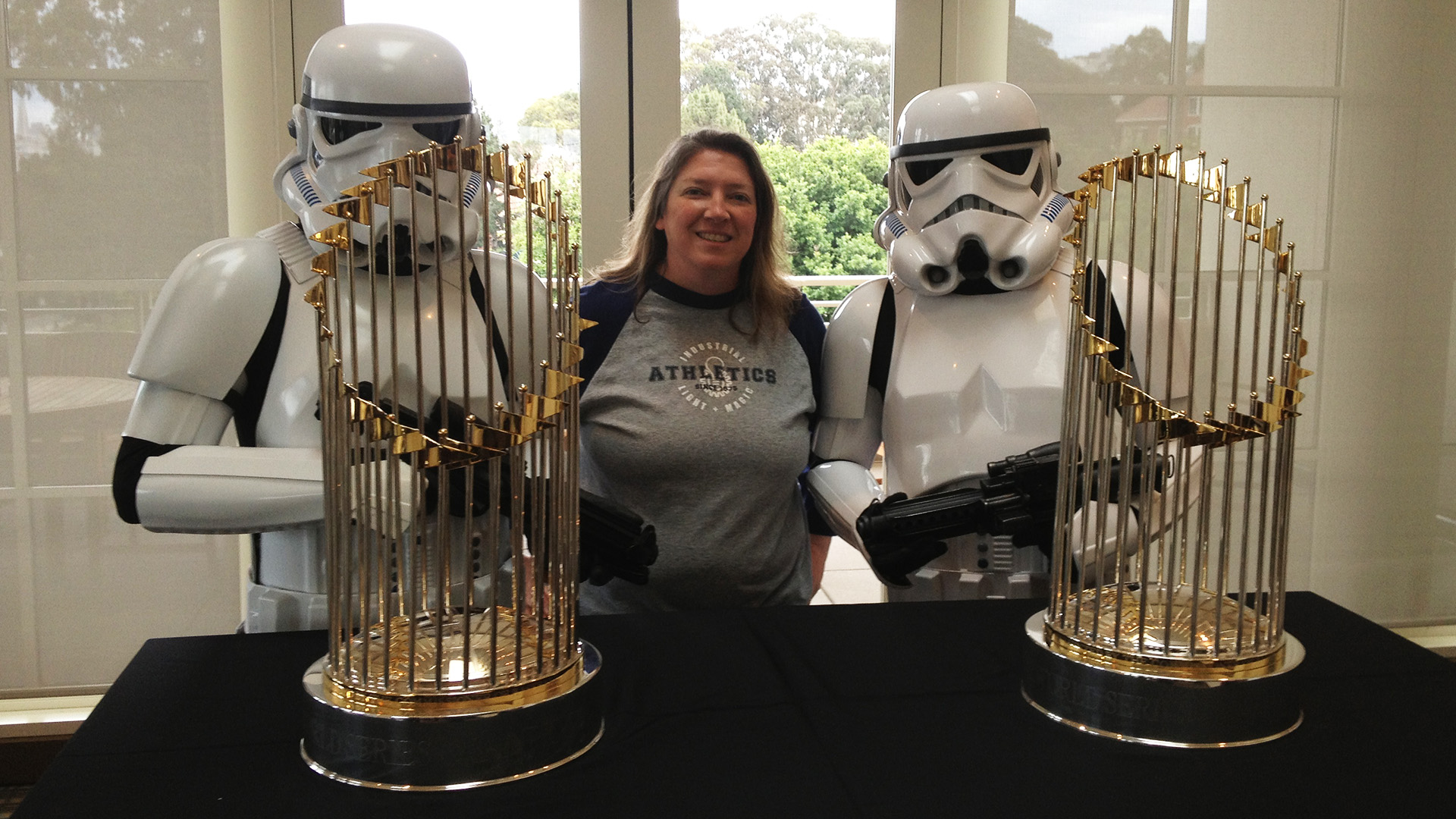Employee Spotlight: Sherry Hitch
The ILM Compositing Supervisor Talks Visual Effects, Loving Star Wars, and Learning Photography
Can you tell us your role at Industrial Light & Magic (ILM) and summarize your day-to-day responsibilities?
It depends on the project! Most recently, I have been working as a compositing supervisor on a film using ILM StageCraft. We weren’t just combining visual effects elements in post-production, but for the actual filming, and creating content for the actual shoot. My day would involve a lot of meetings because this sort of production pipeline is relatively new to many, so we want to ensure our approach in creating the content is well communicated in the best collaborative way. Every week there was something new and challenging for us to tackle. This was not a typical show for compositing. It was centered more on creating all of the environments and the content, because that’s what they shoot on the stage. We are dealing with a massive amount of large imagery, 3D geometry, and data, as well as working with R&D for the best optimization. It’s all rather exciting, and I keep nerding out on this new tech!
What’s it like on a typical production?
If I’m working as a compositing supervisor in post on a typical film, commercial or show, generally we have dailies in the mornings and afternoons. For compositing, you’re trying to blend all the elements (cg, green screen, practical, etc.) together to make them look real – so in dailies, in collaboration with the VFX Supervisor, we’re all making comments about what is changing or what can be improved. Then, afterwards to save time, I’ll follow up and reach out to some of my fellow compositors to ensure that they’re ok with the notes given, and if they need any help with anything. For junior compositors, I will generally reach out to and work with them on individual shots.
It’s a bit more challenging now with work-from-home because normally you can go to a colleague’s desk and work through a problem together. Now I’m doing a lot of screen-sharing. We’ll get together on a group chat and walk through a script about color, or an approach to getting a more efficient result in their shot. Part of the color pipeline also falls into the compositing tasks. You have to make sure everything looks seamless and flows well together in a sequence.
On top of all that, I’ve also done some on-set supervision work too. I’m kind of jumping around a lot right now. I’ve worn a lot of different hats in the last year or two.
It sounds like quality assurance is an important part of your role?
It’s kind of like the Q.C. department. Once we’re done compositing, we make sure nothing is sticking out, before shipping to the client. A compositing lead or a supervisor will “tech-check” a shot the end of the day before it gets shipped to the client. You don’t want to send something that’s half-broken and no one looked at it!
Can you summarize your background and how you came to ILM?
I started at ILM on a six-month contract in January, 2003. Before then, I worked at a small fx boutique company called Foundation Imaging, and we did the visual effects for the first three seasons of Babylon 5, several seasons of Star Trek Voyager, Deep Space Nine, as well as some other television and small film work. I had attended Ball State University in Indiana, which is also the alma mater of television host David Letterman. He donated money to our Film and TV Communications department, including scholarships and internships. I actually received a David Letterman on campus internship, where he paid for a semester of my college, which was awesome. I’ve still never met the man to say thank you, but thank you, Dave! In my senior year, a bunch of us wanted to make the migration to California. So, over a few months we all moved out to Los Angeles. In fact, many of my friends are still down there and still working in the industry.
While at Foundation Imaging, I got my foot in the door as a production assistant. I finally showed my demo reel from college and said, “I’d like to do visual effects too.” I started out in After Effects and Photoshop doing monitor graphics for Babylon 5. Finally, there was an opportunity for me to learn compositing, which I started doing on season two and three. I worked on more TV shows, went out on set, and did film work on the side with other companies. I would work almost all night if I could, just to get the experience of moviemaking. Some of that learning and hard work paid off, as I was nominated for 3 Primetime Emmy awards!
A friend of mine was Todd Vaziri, whom I’d met when he was still in college and I was already working in the industry. Then Todd moved to California, worked in LA, and eventually landed at ILM, and one day out of the blue he said, “Send your reel up here.” And I said, “Yeah, like I have a shot.” I did, and got an interview. Next thing you know, I’m up here, and I’m still here and loving it.
Did you grow up loving art and movies?
I grew up in a small town; Lebanon, Indiana. As a kid, I spent my Saturdays and Sundays watching movies as much as I could. And then Star Wars came out. Among the neighborhood kids, I was the only girl, and all the neighborhood boys had already seen Star Wars. I wanted to see it so badly too. I kept begging my dad to take me. My next-door neighbor had all the Kenner action figures. I had even started to collect them too and hadn’t even seen the movie yet! I finally got to see it, and I wanted to go back again and again.
I also loved art. When I was in junior high school, I started taking Saturday art classes at the Herron School of Art in Indianapolis. It’s about a thirty-three-mile drive one-way. I remember I actually drew a big Star Wars collage in that class. I always loved art and movies, and music, too. I just loved everything creative growing up.
When you came to ILM, you already had a lot of experience in the visual effects industry. What were your first impressions when you arrived here?
I had mainly only worked at small effects shops, the kinds of places where you do multiple tasks yourself. Because ILM was so big, most people were in a specific department. I came from places with just seven people, to hundreds of people at ILM. It was mind-blowing. And at every effects house that I worked at in Los Angeles, I was often the only female, or maybe one of two or three. At ILM there were all these women doing all these different tasks and disciplines. It was incredible.
How did you adjust to performing more specific tasks?
I was working on Master and Commander: The Far Side of the World, and there were a lot of practical effects with difficult blue screens. There was a lot of smoke, or the windows were hard to extract, or there was a lot of hair. And I’ll never forget someone jokingly said, “You know, there’s a button for that?” And I was gullible. I said, “What? To get the blue screen extraction to work?” They said, “Yeah, just get some help from the roto/paint department you can call!” I had been so used to doing all of my own stuff, that I had to learn to let go and that there was a whole department that would help me with it! So now, sometimes I look at something difficult and think it’s going to be really hard for them – and I’m blown away that they just do it like it’s nothing! But having that past experience, I understand what every other discipline is dealing with. When I’m working with someone else, I try to make it easier for them because I’ve been there and I’ve done it. With my composites, I also know what to ask for that will help me.
One of the things that I love about ILM is I can just talk to my colleagues and say, “Hey, have you done this before?” Or you will hear a conversation a few desks over with two people discussing a problem. And you can say, “Oh, I used that tool on another show,” and you can give them advice. Everyone’s so open and everyone’s so friendly about sharing knowledge. Now we’ve got the chat boards and email threads, and you can post a question and someone from the Vancouver studio will have an idea or London will have a tool that you didn’t know about. I love the collaboration.
Do you have any other favorite memories of your early projects at ILM?
After a couple projects, I worked on War of the Worlds. I was on visual effects supervisor Dennis Muren’s team. It was a fast-paced show. I’d never worked so much up to that point, in terms of hours spent at my desk and weekend work. It was exciting. The compositing supervisor was Marshall Krasser, and he allowed me to do some fun shots. It was also nerve-wracking because it’s Dennis Muren, and he’s a legend. In dailies, every time your shot came up, the artist had to go up to the front by the screen and drive their shot. I was so nervous! But I learned so much from Dennis that I still use to this day.
We’d sit there in dailies and watch stuff loop and someone would point out a little thing in the upper left-hand corner that’s not looking quite right. And Dennis would say, “Where’s the action? You’re not looking there. You’re looking over here.” Another technique would be to flop the shot to look at it with a new, fresh eye. You just flop the shot and watch from this new perspective. Did you see something new? Is there something that you want to change? Those are the techniques that I’ve always taken to heart from Dennis and War of the Worlds.
What project have you most enjoyed in recent years?
One that stands out currently is Star Wars: The Force Awakens. I was a sequence lead on that. Apart from being a big Star Wars fan, it was exciting for the fact that it was J.J. Abrams and we were bringing Star Wars back. Jay Cooper was compositing supervisor on that one, and he asked me to take the lightsaber duel with Rey and Kylo Ren in the snow. I got to oversee the sequence for color and make sure Rey’s lightsaber looked like Luke Skywalker’s from the earlier films, along with any technical aspects that folks needed help and collaboration with for their shots. It was a fun crew, with a lot of real Star Wars fans on the show, which made the experience all that more special.
Are there any types of skills or attributes (beyond the normal qualifications) that you think are important for someone in your role or one like it?
Photography skills are important as a compositor. When you’re in dailies, someone might be talking about the focus or other photographic qualities of a shot. The tools are getting more and more advanced now where you can mimic a lens, practical physical organic effects, and do the impossible. Knowing the terminology, and having an understanding of what the camera does and how it manipulates an image is very important. It’s not just computers. It’s not just writing a script. Practical experience is so beneficial to being able to develop your skills. Go out and shoot stuff yourself to learn things. Become an artist with a talented eye.
Do you have any other favorite memories or experiences from over the years?
I love all of the fundraisers that we do as a company. Before ILM came to Letterman Digital Arts Center we did a spelling bee contest to raise money. Now we do our Trivia Night fundraiser every year. It’s fun to collaborate with your fellow coworkers and be on a team with people from other parts of the company. I’m never on the winning team, but a couple of years ago we came in second, and I thought that was exciting. But I love that everyone here is so caring, and so willing to help others.
Shifting topics, do you have a favorite character from a Lucasfilm production?
I have too many! I love Princess Leia. She was a strong female character. She didn’t take any crap. I love how George Lucas wrote her to be one of the first heroines that I could idolize as a little girl, at the time. I also like Chewbacca because I love dogs. He just reminds me of a fluffy, loving, lovable dog. Then there’s R2-D2. He’s so quirky, it always provides a comedic element to everything.
What advice would you give to someone looking to apply at ILM, or more specifically, to work in your role as a compositor?
Apart from photography skills, I would say they should try shooting some relatively easy shots on an iphone, or any other camera they have at their disposal. Try to mimic a shot from a favorite film, and add in elements that were not in what was photographed (from adding in a cg car, ship or anything in their imagination) and use software that is at their disposal. Learn to look at all the aspects of the shot from matching color, lighting direction, shadows, and composition when trying to make it look real. Watching reference is HUGE. Looking at real footage has always helped all of us, before we tackle a shot for real. Getting used to seeing the details in everyday life can be really helpful!
Lucas O. Seastrom is a writer and historian at Lucasfilm.



